Mathematica evaluates the Mellin transforms for 1 and $x^j$ as follows.
(a) $\quad\mathcal{M}_x[1](s)=\delta(s)$
(b) $\quad\mathcal{M}_x\left[x^j\right](s)=\delta(s+j)$
The following Mathematica inverse Mellin transform evaluations are consistent with (a) and (b) above.
(c) $\quad\mathcal{M}_s^{-1}[\delta(s)](x)=1$
(d) $\quad\mathcal{M}_s^{-1}[\delta(s+j)](x)=x^j$
The inverse Mellin inverse transform is defined as follows.
(e) $\quad\mathcal{M}_s^{-1}[F(s)](x)=\frac{1}{2\,\pi\,i}\int\limits_{c-i\,\infty}^{c+i\,\infty}F(s)\,x^{-s}\,ds$
The inverse Mellin transform evaluations (c) and (d) above which are illustrated in integral form below don't make sense because the $\delta(s)$ function is intended to be integrated along the real axis and the inverse Mellin transform is integrated along a line perpendicular to the real axis.
(f) $\quad\mathcal{M}_s^{-1}[\delta (s)](x)=\frac{1}{2\,\pi\,i}\int\limits_{c-i\,\infty}^{c+i\,\infty}\delta(s)\,x^{-s}\,ds=1$
(g) $\quad\mathcal{M}_s^{-1}[\delta(j+s)](x)=\frac{1}{2\,\pi\,i}\int\limits_{c-i\,\infty}^{c+i\,\infty}\delta(s+j)\,x^{-s}\,ds=x^j$
The following Mathematica evaluation illustrates the Mellin transform of 1 should be $2\,\pi\,\delta(i\,s)$ instead of $\delta(s)$.
(h) $\quad\frac{1}{2\,\pi\,i}\int\limits_{-i\,\infty}^{i\,\infty}(2\,\pi\,\delta(i\,s))\,x^{-s}\,ds=1$
Integral (h) above is along the imaginary axis, but substituting $s=-i\,t$ into integral (h) above results in the following integral along the real axis.
(i) $\quad\frac{1}{2\,\pi\,i}\int\limits_{-\infty }^{\infty}(2\,\pi\,\delta\,(t))\,x^{i\,t}\,i\,dt=x^0=1$
The result above implies the Mellin transform of $x^j$ should be $2\,\pi\,\delta(i\,(s+j))$ instead of $\delta(s+j)$, and the corresponding inverse Mellin transform can be evaluated as follows.
(j) $\quad\frac{1}{2\,\pi\,i}\int\limits_{-\Re(j)-i\,\infty}^{-\Re(j)+i\,\infty}(2\,\pi\,\delta(i\,(s+j)))\,x^{-s}\,ds=x^j$
Mathematica isn't capable of evaluating integral (j) above, but Mathematica is capable of evaluating the following integral along the real axis which is derived from (j) above by substituting $s=-i\,t-\Re(j)$.
(k) $\quad\frac{1}{2\,\pi\,i}\int\limits_{-\infty}^{\infty}(2\,\pi\,\delta(t-\Im(j)))\,x^{i\,t+\Re(j)}\,i\,dt=x^j$
For further illustration of the correctness of the Mellin transform $\mathcal{M}_s[1](x)=2\,\pi\,\delta(i\,s)$, consider the limit representation of $\delta(x)$ illustrated in (l) below and the two associated Mathematica evaluations illustrated in (m) and (n) below both of which corroborate $\mathcal{M}_s[1](x)=2\,\pi\,\delta(i\,s)$. The result illustrated in (m) below was obtained using the Mathematica $InverseMellinTransform$ function. Note for $A=\infty$ the result illustrated in (m) below evaluates to $1$ for $x>0$. The result illustrated in (n) below was obtained using the Mathematica $Integrate$ function using the assumption $x<A$.
(l) $\quad T_A(x)=\frac{1}{2\,\pi}\int\limits_{-A}^A\,e^{i\,t\,x}\, dt=\frac{\sin(A\,x)}{\pi\,x},\quad A\to\infty$
(m) $\quad\mathcal{M}_s^{-1}[2\,\pi\,T_A(i\,s)](x)=\theta(A-\log(x))-\theta(-A-\log (x)),\quad 0<x<1$
(n)$\quad\frac{1}{2\,\pi\,i}\int_{-i\,\infty}^{i\,\infty}2\,\pi\,T_A(i\,s)\,x^{-s}\,ds=1\,,\quad 1\leq x<A$
########
I originally posted the following exploration into defining a $\delta(s)$ function along the imaginary axis. This approach was misguided but provided some insight which eventually helped me to realize the correct answer I posted above and also provided the context for some of the comments below, so I decided to retain the original exploration I posted below rather than delete it.
########
I believe I've made some progress in making sense of a delta function integrated along the imaginary axis, but this seems to require an extension of the distributional framework (at least as I understand it). In the remainder of this answer, I use $\delta^*(s)$ to refer to a delta function intended to be integrated along the imaginary axis to distinguish it from the traditional delta function $\delta(s)$ intended to be integrated along the real axis. Likewise I use $\theta^*(s)$ to refer to a Heaviside step function intended to be evaluated along the imaginary axis to distinguish it from the traditional Heaviside step function $\theta(s)$ intended to be evaluated along the real axis.
The Mellin transform of $1$ and the associated inverse Mellin transform are as follows. Mathematica evaluates the Mellin transform of 1 as $\delta(s)$, but I believe the result should be $\delta^*(s)$ versus the traditional definition of $\delta(s)$.
(1) $\quad\mathcal{M}_x[1](s)=\int\limits_0^\infty 1\,x^{s-1}\,dx=\delta^*(s)$
(2) $\quad \mathcal{M}_s^{-1}[\delta^*(s)](x)=\frac{1}{2\,\pi\,i}\int\limits_{-i\infty}^{i\infty}\delta^*(s)\,x^{-s}\,ds=1$
The Mellin transform pair illustrated in (1) and (2) above seems to imply the following.
(3) $\quad\int\limits_{-i\infty}^{i\infty}\delta^*(s)\,ds=2\,\pi\,i$
Consider the following approximation to $\delta^*(s)$ which is an approximation to the Mellin transform of 1. Mathematica indicates the integral below converges for $Re(s)<0$, but evaluation at $Re(s)=0$ along the imaginary axis produces some encouraging results which are illustrated below.
(4) $\quad\delta^*(s)\approx T_a(s)=\int\limits_a^\infty 1\,x^{s-1}\, dx=-\frac{a^s}{s},\quad a\to 0^+$
The following three plots illustrate the real part, imaginary part, and absolute value of $T_a(s)$ evaluated along the imaginary axis for $a=0.1$ (green), $a=0.01$ (orange), and $a=0.001$ (blue). In the third plot below for the absolute value of $T_a(s)$, all three evaluation limits for $a$ result in the same evaluation and hence the green, orange, and blue curves overlap each other.
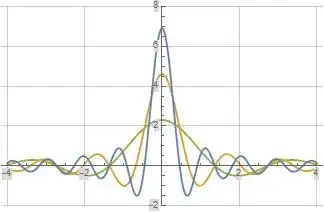
Figure (1): $\Re(T_a(s))$ Evaluated Along the Imaginary Axis
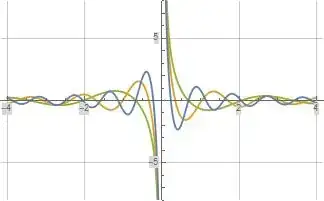
Figure (2): $\Im(T_a(s))$ Evaluated Along the Imaginary Axis

Figure (3): $\left|T_a(s)\right|$ Evaluated Along the Imaginary Axis
The following plot illustrates $T_a(s)$ evaluated along the real axis for $a=0.1$ (green), $a=0.01$ (orange), and $a=0.001$ (blue). Assuming $a\to 0^+$, $T_a(s)$ diverges to $+\infty$ as $s\to-\infty$, and $T_a(s)$ converges to $0$ as $s\to+\infty$.

Figure (4): $T_a(s)$ Evaluated Along the Real Axis
Now consider the following integral which is an approximation to and consistent with integral (3) above. Note that $i\,(\pi-2\,\text{Si}\,(-\infty))=2\,\pi\,i$.
(5) $\quad\int\limits_{-i\,N}^{i\,N}T_a(s)\,ds=i\,(\pi-2\,\text{Si}\,(N\,\log(a)))\approx 2\,\pi\,i\,,\quad a\to0^+\land N\to\infty^-$
Now consider the following integral which is an approximation to and consistent with the inverse Mellin transform of $\delta^*(s)$ in (2) above. Mathematica indicates the integral below converges for $\Re(\log(x))>0$, but it actually seems to converge for $x>0$.
(6) $\quad\frac{1}{2\,\pi\,i}\int\limits_{-i\,N}^{i\,N}T_a(s)\,x^{-s}\,ds=\frac{(\text{Ei}(-i\,N\,(\log(a)-\log (x)))-\text{Ei}(i\,N\,(\log(a)-\log(x))))}{2\,\pi\,i}\approx 1\,,\qquad x>0\land a\to 0^+\land N\to\infty^-$
The following plot illustrates the evaluation of formula (6) above evaluated at $a=0.001$ and $N=1,000$. The blue and orange curves represent the real and imaginary parts of formula (6) respectively. I'll note formula (6) only converges to 1 for $x>0$.

Figure (5): Formula (6) illustrated at $a=0.001$ and $N=1,000$
Next consider the following approximation to $\theta^*(s)$.
(7) $\quad\theta^*(s)\approx\int\limits_{-i\,\infty}^s T_a(z)\,dz=-\text{Ei}(s\,\log(a))+i\,\pi\,,\quad \Re(s)=0\land a\to 0^+$
The following three plots illustrate the real part, imaginary part, and absolute value of formula (7) above evaluated along the imaginary axis for $a=0.1$ (green), $a=0.01$ (orange), and $a=0.001$ (blue).
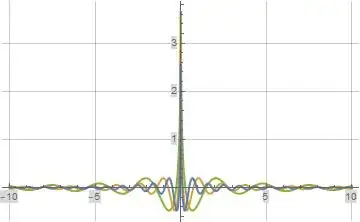
Figure (6): Real part of formula (7) Evaluated Along the Imaginary Axis
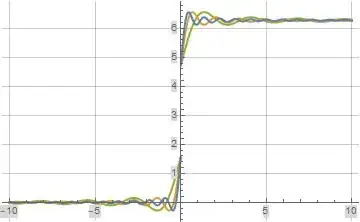
Figure (7): Imaginary part of formula (7) Evaluated Along the Imaginary Axis
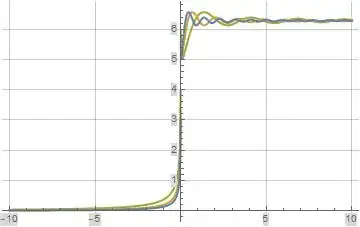
Figure (8): Absolute Value of formula (7) Evaluated Along the Imaginary Axis
The following plot illustrates an expanded view of the real part of formula (7) defined above.

Figure (9): Expanded View of Real part of formula (7) Evaluated Along the Imaginary Axis
Finally consider the following function which represents $T_a(s)$ evaluated at $s=i\,t$ and $a=e^{-A}$. The evaluation of $T_A(t)$ along the real axis as $A\to\infty^-$ is analogous to the evaluation of $T_a(s)$ along the imaginary axis as $a\to 0^+$, but I can't seem to derive the integrals for $T_A(t)$ which are analogous to the integrals associated with $T_a(s)$ defined and illustrated above.
(8) $\quad T_A(t)=\frac{\sin(A\,t)}{t}+\frac{i\,\cos(A\,t)}{t},\quad t\in \mathbb{R}\land A\to\infty-$
12/5/2017 Update: I wasn't happy with the following aspects of the limit representation $Ta(s)=-\frac{a^s}{s}$ for $\delta^*(s)$ defined in formula (4) above, so this update explores an alternate limit representation for $\delta^*(s)$ which eliminates these problems and therefore I believe is more correct.
- Inability to evaluate formulas (5) and (6) above at infinite integration limits.
- Non-zero value of $\Im(T_a(s))$ illustrated in figure (2) above.
- Non-zero value of real part of formula (7) illustrated in figures (6) and (9) above.
The alternate limit representation for $\delta^*(s)$ is defined as follows.
(9) $\quad\delta^*(s)=T_1(s)=\frac{2\,\sinh(A\,s)}{s},\quad \Re(s)=0\land A\to\infty$
The following two plots illustrate the real part and imaginary part of $T_1(s)$ evaluated along the imaginary axis for $A=2$ (green), $A=4$ (orange), and $A=8$ (blue).
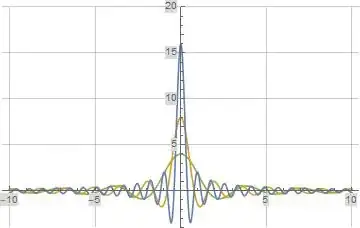
Figure (10): $\Re(T_1(s))$ Evaluated Along the Imaginary Axis
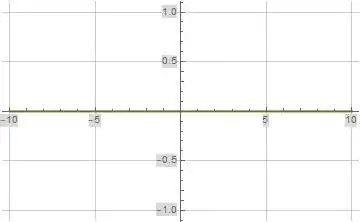
Figure (11): $\Im(T_1(s))$ Evaluated Along the Imaginary Axis
Now consider the following integral which is consistent with integral (3) above.
(10) $\quad\int\limits_{-i\,\infty}^{i\,\infty}T_1(s)\,ds=2\,\pi\,i$
Now consider the following integral which evaluates to $1$ for $x>0$ and $A>\log(x)$ and therefore is consistent with the inverse Mellin transform of $\delta^*(s)$ in (2) above.
(11) $\quad\frac{1}{2\,\pi\,i}\int\limits_{-i\,\infty}^{i\,\infty}T_1(s)\,x^{-s}\,ds=\frac{1}{2}\left(1+\frac{1}{\text{sgn}(A-\log(x))}\right)=1\,,\qquad x>0\land A\to\infty$
Next consider the following limit representation of $\theta^*(s)$.
(12) $\quad\theta^*(s)=\int\limits_{-i\,\infty}^s T_1(z)\,dz=2\,\text{Shi}(A\,s)+i\,\pi\,,\quad \Re(s)=0\land A\to\infty$
The following two plots illustrate the real part and imaginary part of formula (12) above evaluated along the imaginary axis for $A=2$ (green), $A=4$ (orange), and $A=8$ (blue).
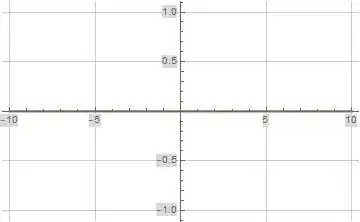
Figure (12): Real part of formula (12) Evaluated Along the Imaginary Axis
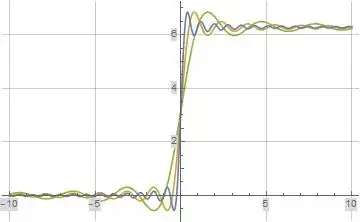
Figure (13): Imaginary part of formula (12) Evaluated Along the Imaginary Axis












